Article Critique: Analyzing Stress and Performance in Nursing Students
VerifiedAdded on 2023/06/09
|12
|2508
|250
Essay
AI Summary
This essay presents a comprehensive critique of an article investigating the relationship between perceived stress and clinical performance among nursing students. The critique covers various aspects of the research, including the study's background, purpose, methodology, findings, and limitations. The original study used a descriptive, correlational, and cross-sectional design to assess stress levels and clinical performance in Jordanian nursing students. The findings indicated a negative correlation between stress and performance, particularly among female students. The critique highlights the study's strengths, such as its ethical considerations and relevant literature review, while also pointing out limitations like the lack of a detailed list of questionnaire questions. The essay concludes by summarizing the study's implications and offering a student's perspective on the research.
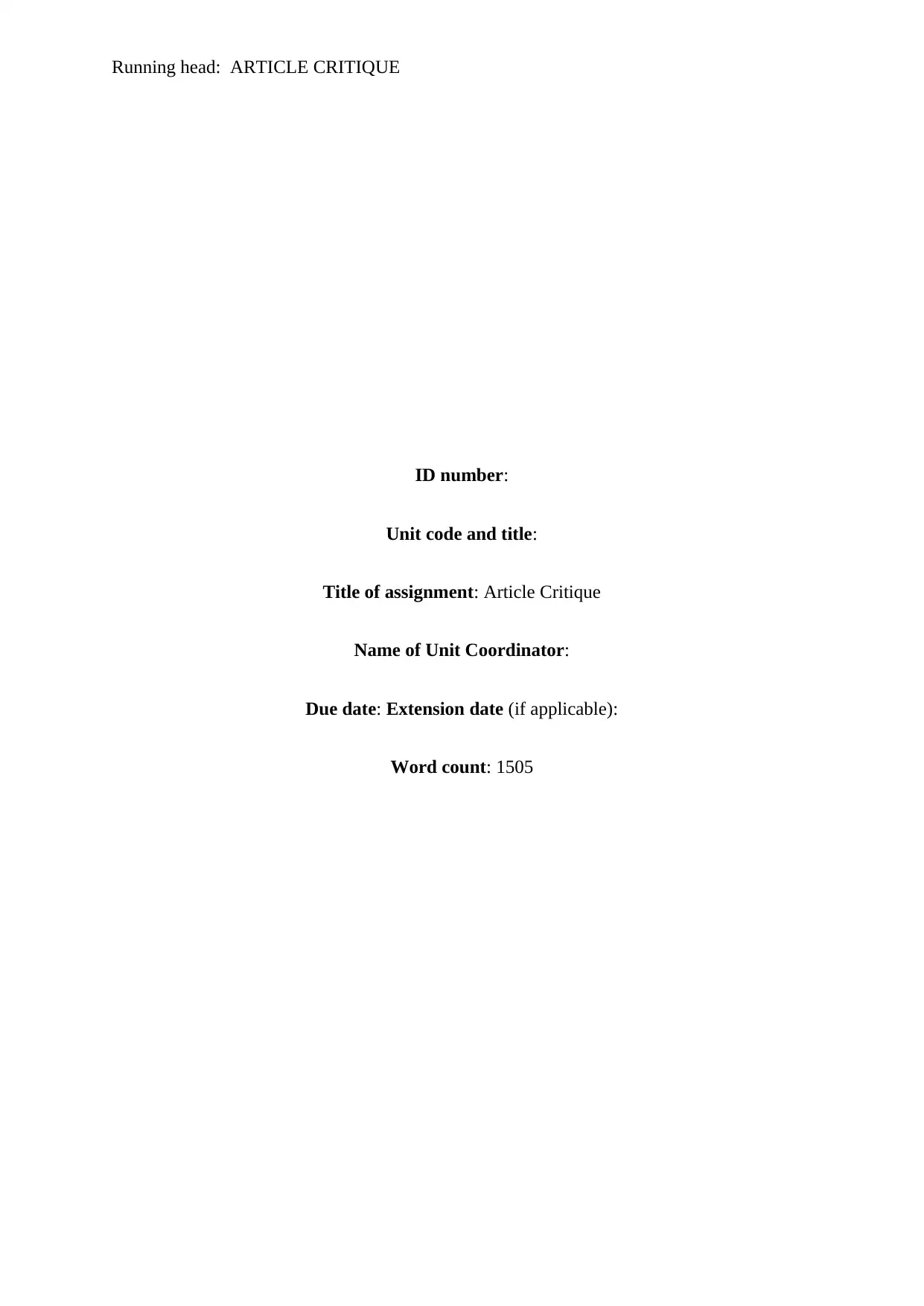
Running head: ARTICLE CRITIQUE
ID number:
Unit code and title:
Title of assignment: Article Critique
Name of Unit Coordinator:
Due date: Extension date (if applicable):
Word count: 1505
ID number:
Unit code and title:
Title of assignment: Article Critique
Name of Unit Coordinator:
Due date: Extension date (if applicable):
Word count: 1505
Paraphrase This Document
Need a fresh take? Get an instant paraphrase of this document with our AI Paraphraser
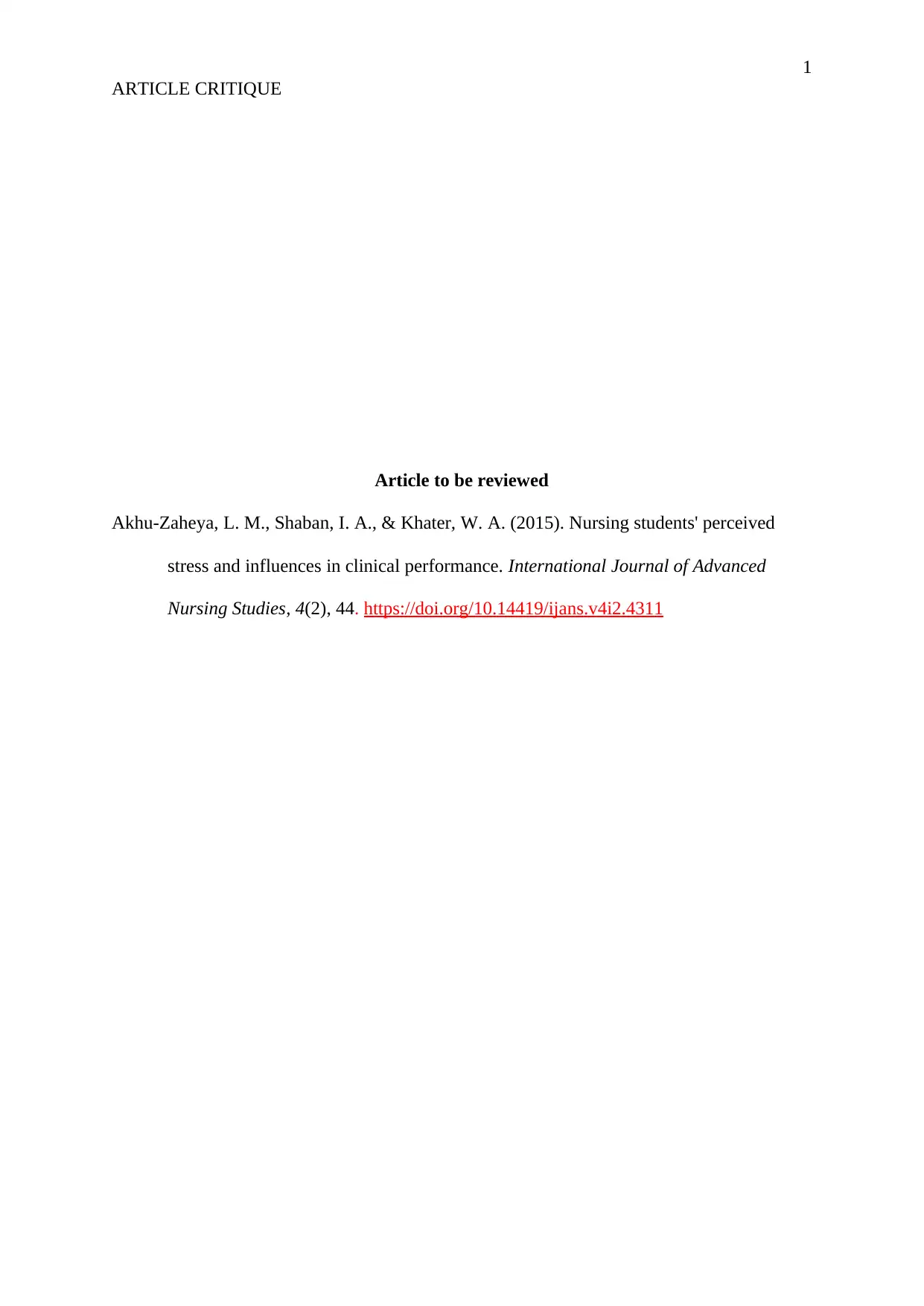
1
ARTICLE CRITIQUE
Article to be reviewed
Akhu-Zaheya, L. M., Shaban, I. A., & Khater, W. A. (2015). Nursing students' perceived
stress and influences in clinical performance. International Journal of Advanced
Nursing Studies, 4(2), 44. https://doi.org/10.14419/ijans.v4i2.4311
ARTICLE CRITIQUE
Article to be reviewed
Akhu-Zaheya, L. M., Shaban, I. A., & Khater, W. A. (2015). Nursing students' perceived
stress and influences in clinical performance. International Journal of Advanced
Nursing Studies, 4(2), 44. https://doi.org/10.14419/ijans.v4i2.4311
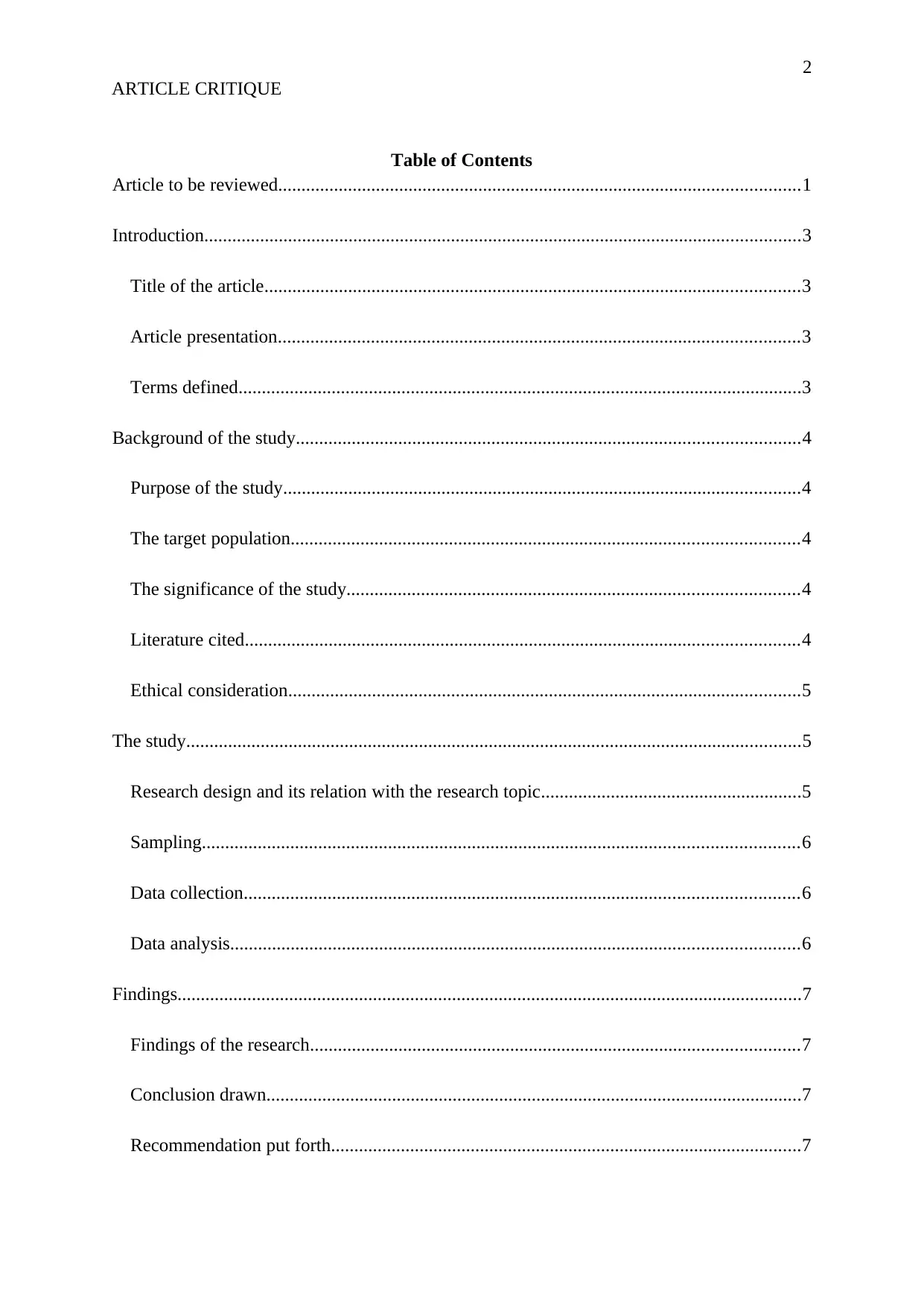
2
ARTICLE CRITIQUE
Table of Contents
Article to be reviewed................................................................................................................1
Introduction................................................................................................................................3
Title of the article...................................................................................................................3
Article presentation................................................................................................................3
Terms defined.........................................................................................................................3
Background of the study............................................................................................................4
Purpose of the study...............................................................................................................4
The target population.............................................................................................................4
The significance of the study.................................................................................................4
Literature cited.......................................................................................................................4
Ethical consideration..............................................................................................................5
The study....................................................................................................................................5
Research design and its relation with the research topic........................................................5
Sampling................................................................................................................................6
Data collection.......................................................................................................................6
Data analysis..........................................................................................................................6
Findings......................................................................................................................................7
Findings of the research.........................................................................................................7
Conclusion drawn...................................................................................................................7
Recommendation put forth.....................................................................................................7
ARTICLE CRITIQUE
Table of Contents
Article to be reviewed................................................................................................................1
Introduction................................................................................................................................3
Title of the article...................................................................................................................3
Article presentation................................................................................................................3
Terms defined.........................................................................................................................3
Background of the study............................................................................................................4
Purpose of the study...............................................................................................................4
The target population.............................................................................................................4
The significance of the study.................................................................................................4
Literature cited.......................................................................................................................4
Ethical consideration..............................................................................................................5
The study....................................................................................................................................5
Research design and its relation with the research topic........................................................5
Sampling................................................................................................................................6
Data collection.......................................................................................................................6
Data analysis..........................................................................................................................6
Findings......................................................................................................................................7
Findings of the research.........................................................................................................7
Conclusion drawn...................................................................................................................7
Recommendation put forth.....................................................................................................7
⊘ This is a preview!⊘
Do you want full access?
Subscribe today to unlock all pages.

Trusted by 1+ million students worldwide
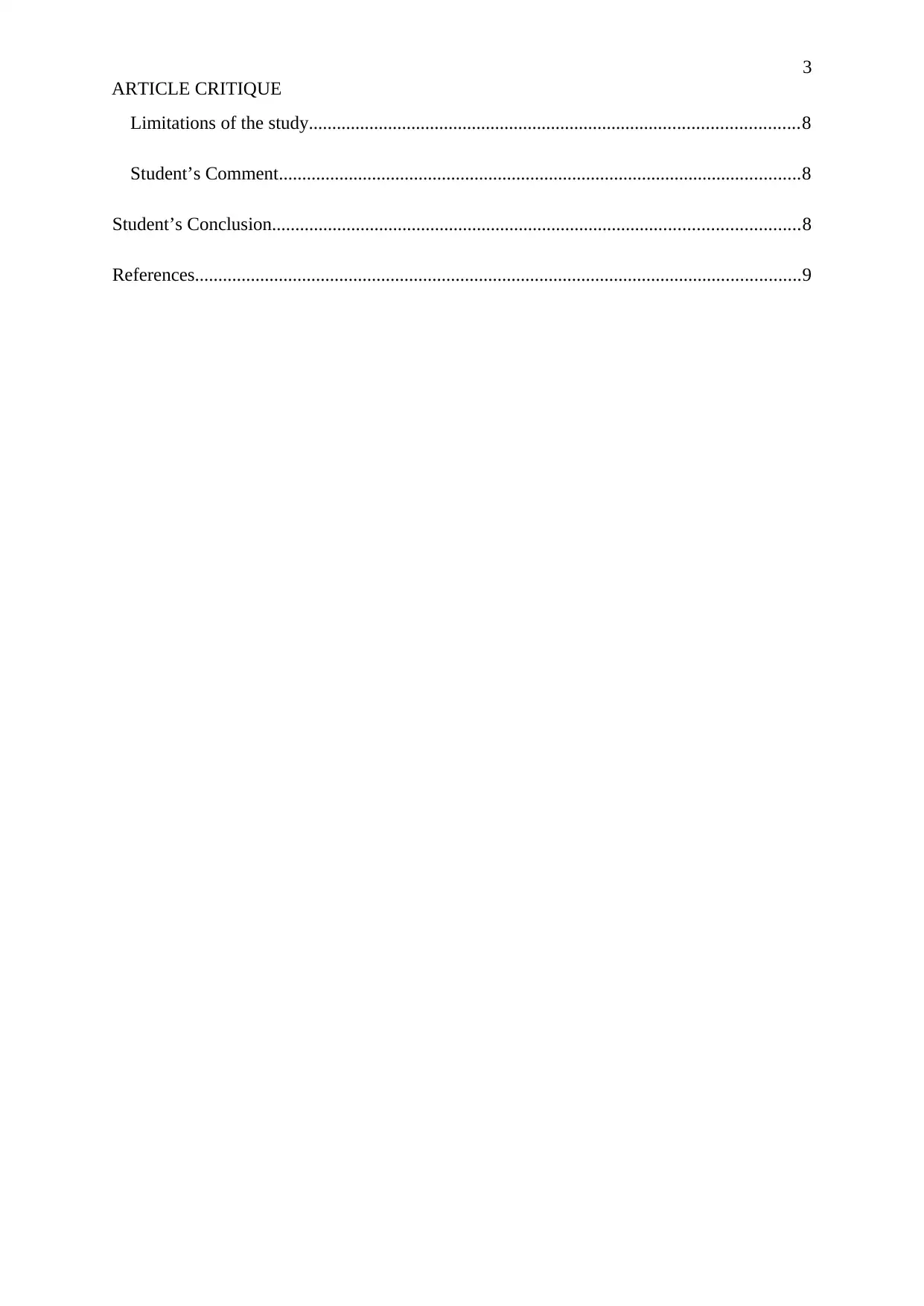
3
ARTICLE CRITIQUE
Limitations of the study.........................................................................................................8
Student’s Comment................................................................................................................8
Student’s Conclusion.................................................................................................................8
References..................................................................................................................................9
ARTICLE CRITIQUE
Limitations of the study.........................................................................................................8
Student’s Comment................................................................................................................8
Student’s Conclusion.................................................................................................................8
References..................................................................................................................................9
Paraphrase This Document
Need a fresh take? Get an instant paraphrase of this document with our AI Paraphraser
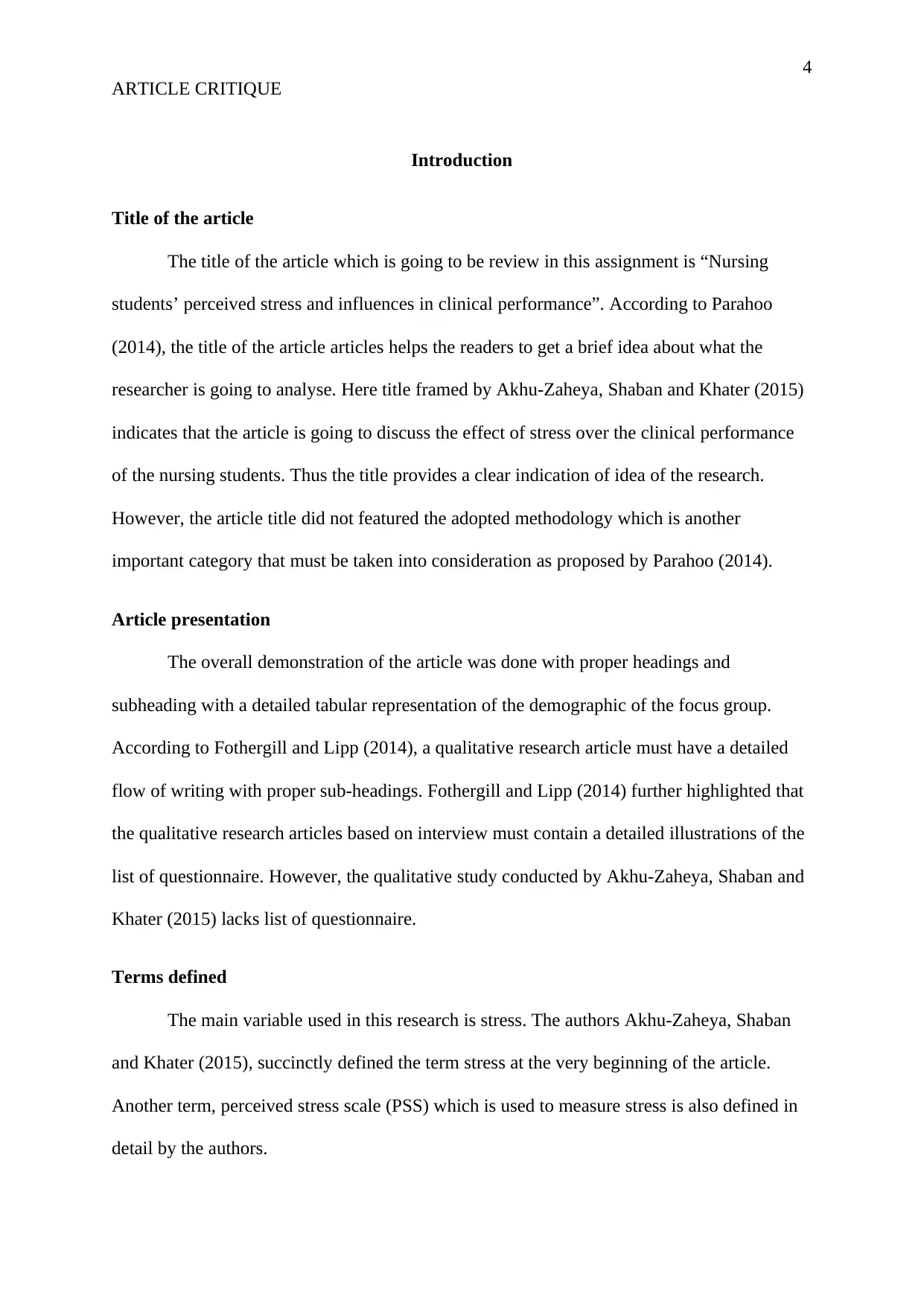
4
ARTICLE CRITIQUE
Introduction
Title of the article
The title of the article which is going to be review in this assignment is “Nursing
students’ perceived stress and influences in clinical performance”. According to Parahoo
(2014), the title of the article articles helps the readers to get a brief idea about what the
researcher is going to analyse. Here title framed by Akhu-Zaheya, Shaban and Khater (2015)
indicates that the article is going to discuss the effect of stress over the clinical performance
of the nursing students. Thus the title provides a clear indication of idea of the research.
However, the article title did not featured the adopted methodology which is another
important category that must be taken into consideration as proposed by Parahoo (2014).
Article presentation
The overall demonstration of the article was done with proper headings and
subheading with a detailed tabular representation of the demographic of the focus group.
According to Fothergill and Lipp (2014), a qualitative research article must have a detailed
flow of writing with proper sub-headings. Fothergill and Lipp (2014) further highlighted that
the qualitative research articles based on interview must contain a detailed illustrations of the
list of questionnaire. However, the qualitative study conducted by Akhu-Zaheya, Shaban and
Khater (2015) lacks list of questionnaire.
Terms defined
The main variable used in this research is stress. The authors Akhu-Zaheya, Shaban
and Khater (2015), succinctly defined the term stress at the very beginning of the article.
Another term, perceived stress scale (PSS) which is used to measure stress is also defined in
detail by the authors.
ARTICLE CRITIQUE
Introduction
Title of the article
The title of the article which is going to be review in this assignment is “Nursing
students’ perceived stress and influences in clinical performance”. According to Parahoo
(2014), the title of the article articles helps the readers to get a brief idea about what the
researcher is going to analyse. Here title framed by Akhu-Zaheya, Shaban and Khater (2015)
indicates that the article is going to discuss the effect of stress over the clinical performance
of the nursing students. Thus the title provides a clear indication of idea of the research.
However, the article title did not featured the adopted methodology which is another
important category that must be taken into consideration as proposed by Parahoo (2014).
Article presentation
The overall demonstration of the article was done with proper headings and
subheading with a detailed tabular representation of the demographic of the focus group.
According to Fothergill and Lipp (2014), a qualitative research article must have a detailed
flow of writing with proper sub-headings. Fothergill and Lipp (2014) further highlighted that
the qualitative research articles based on interview must contain a detailed illustrations of the
list of questionnaire. However, the qualitative study conducted by Akhu-Zaheya, Shaban and
Khater (2015) lacks list of questionnaire.
Terms defined
The main variable used in this research is stress. The authors Akhu-Zaheya, Shaban
and Khater (2015), succinctly defined the term stress at the very beginning of the article.
Another term, perceived stress scale (PSS) which is used to measure stress is also defined in
detail by the authors.
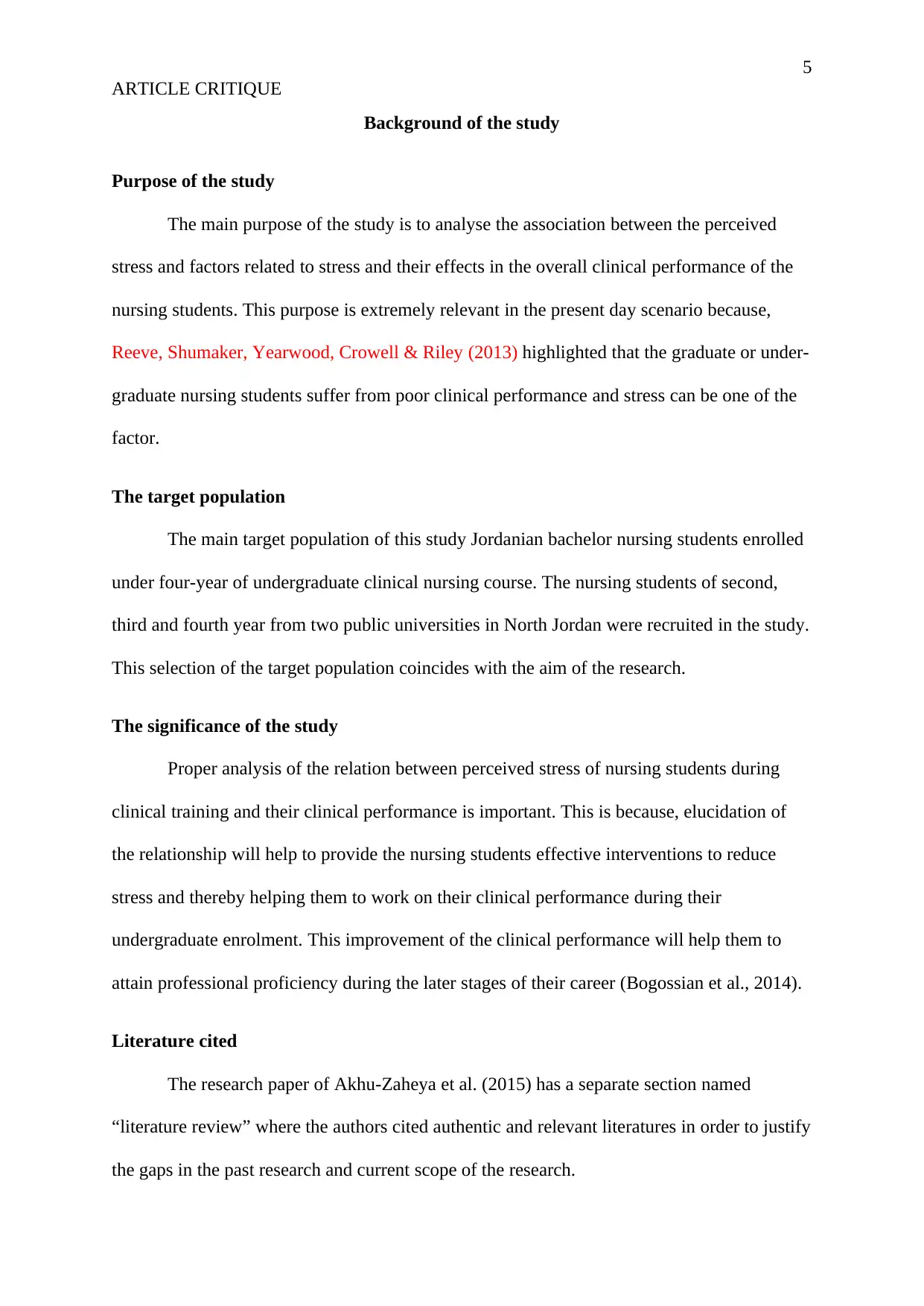
5
ARTICLE CRITIQUE
Background of the study
Purpose of the study
The main purpose of the study is to analyse the association between the perceived
stress and factors related to stress and their effects in the overall clinical performance of the
nursing students. This purpose is extremely relevant in the present day scenario because,
Reeve, Shumaker, Yearwood, Crowell & Riley (2013) highlighted that the graduate or under-
graduate nursing students suffer from poor clinical performance and stress can be one of the
factor.
The target population
The main target population of this study Jordanian bachelor nursing students enrolled
under four-year of undergraduate clinical nursing course. The nursing students of second,
third and fourth year from two public universities in North Jordan were recruited in the study.
This selection of the target population coincides with the aim of the research.
The significance of the study
Proper analysis of the relation between perceived stress of nursing students during
clinical training and their clinical performance is important. This is because, elucidation of
the relationship will help to provide the nursing students effective interventions to reduce
stress and thereby helping them to work on their clinical performance during their
undergraduate enrolment. This improvement of the clinical performance will help them to
attain professional proficiency during the later stages of their career (Bogossian et al., 2014).
Literature cited
The research paper of Akhu-Zaheya et al. (2015) has a separate section named
“literature review” where the authors cited authentic and relevant literatures in order to justify
the gaps in the past research and current scope of the research.
ARTICLE CRITIQUE
Background of the study
Purpose of the study
The main purpose of the study is to analyse the association between the perceived
stress and factors related to stress and their effects in the overall clinical performance of the
nursing students. This purpose is extremely relevant in the present day scenario because,
Reeve, Shumaker, Yearwood, Crowell & Riley (2013) highlighted that the graduate or under-
graduate nursing students suffer from poor clinical performance and stress can be one of the
factor.
The target population
The main target population of this study Jordanian bachelor nursing students enrolled
under four-year of undergraduate clinical nursing course. The nursing students of second,
third and fourth year from two public universities in North Jordan were recruited in the study.
This selection of the target population coincides with the aim of the research.
The significance of the study
Proper analysis of the relation between perceived stress of nursing students during
clinical training and their clinical performance is important. This is because, elucidation of
the relationship will help to provide the nursing students effective interventions to reduce
stress and thereby helping them to work on their clinical performance during their
undergraduate enrolment. This improvement of the clinical performance will help them to
attain professional proficiency during the later stages of their career (Bogossian et al., 2014).
Literature cited
The research paper of Akhu-Zaheya et al. (2015) has a separate section named
“literature review” where the authors cited authentic and relevant literatures in order to justify
the gaps in the past research and current scope of the research.
⊘ This is a preview!⊘
Do you want full access?
Subscribe today to unlock all pages.

Trusted by 1+ million students worldwide
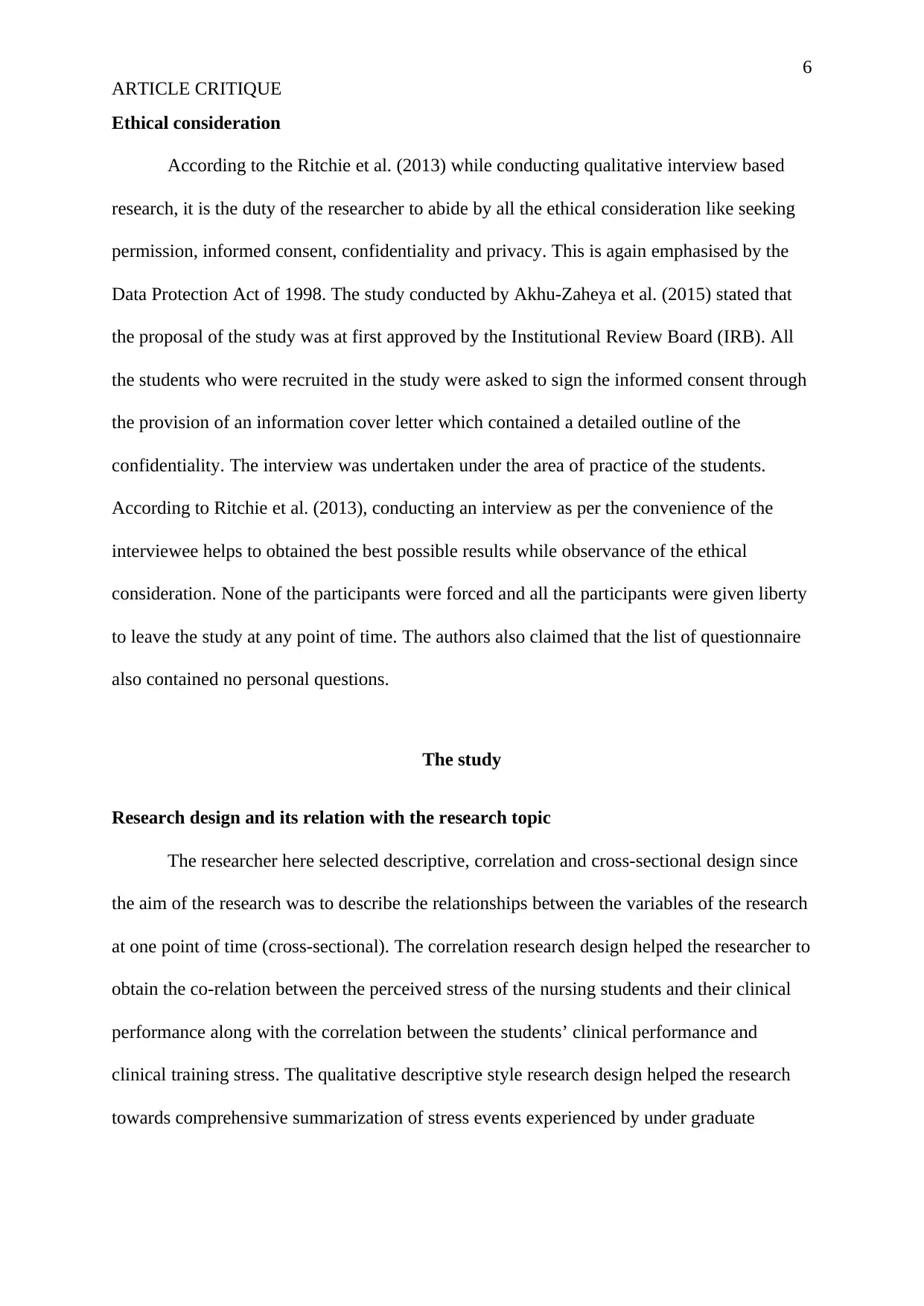
6
ARTICLE CRITIQUE
Ethical consideration
According to the Ritchie et al. (2013) while conducting qualitative interview based
research, it is the duty of the researcher to abide by all the ethical consideration like seeking
permission, informed consent, confidentiality and privacy. This is again emphasised by the
Data Protection Act of 1998. The study conducted by Akhu-Zaheya et al. (2015) stated that
the proposal of the study was at first approved by the Institutional Review Board (IRB). All
the students who were recruited in the study were asked to sign the informed consent through
the provision of an information cover letter which contained a detailed outline of the
confidentiality. The interview was undertaken under the area of practice of the students.
According to Ritchie et al. (2013), conducting an interview as per the convenience of the
interviewee helps to obtained the best possible results while observance of the ethical
consideration. None of the participants were forced and all the participants were given liberty
to leave the study at any point of time. The authors also claimed that the list of questionnaire
also contained no personal questions.
The study
Research design and its relation with the research topic
The researcher here selected descriptive, correlation and cross-sectional design since
the aim of the research was to describe the relationships between the variables of the research
at one point of time (cross-sectional). The correlation research design helped the researcher to
obtain the co-relation between the perceived stress of the nursing students and their clinical
performance along with the correlation between the students’ clinical performance and
clinical training stress. The qualitative descriptive style research design helped the research
towards comprehensive summarization of stress events experienced by under graduate
ARTICLE CRITIQUE
Ethical consideration
According to the Ritchie et al. (2013) while conducting qualitative interview based
research, it is the duty of the researcher to abide by all the ethical consideration like seeking
permission, informed consent, confidentiality and privacy. This is again emphasised by the
Data Protection Act of 1998. The study conducted by Akhu-Zaheya et al. (2015) stated that
the proposal of the study was at first approved by the Institutional Review Board (IRB). All
the students who were recruited in the study were asked to sign the informed consent through
the provision of an information cover letter which contained a detailed outline of the
confidentiality. The interview was undertaken under the area of practice of the students.
According to Ritchie et al. (2013), conducting an interview as per the convenience of the
interviewee helps to obtained the best possible results while observance of the ethical
consideration. None of the participants were forced and all the participants were given liberty
to leave the study at any point of time. The authors also claimed that the list of questionnaire
also contained no personal questions.
The study
Research design and its relation with the research topic
The researcher here selected descriptive, correlation and cross-sectional design since
the aim of the research was to describe the relationships between the variables of the research
at one point of time (cross-sectional). The correlation research design helped the researcher to
obtain the co-relation between the perceived stress of the nursing students and their clinical
performance along with the correlation between the students’ clinical performance and
clinical training stress. The qualitative descriptive style research design helped the research
towards comprehensive summarization of stress events experienced by under graduate
Paraphrase This Document
Need a fresh take? Get an instant paraphrase of this document with our AI Paraphraser
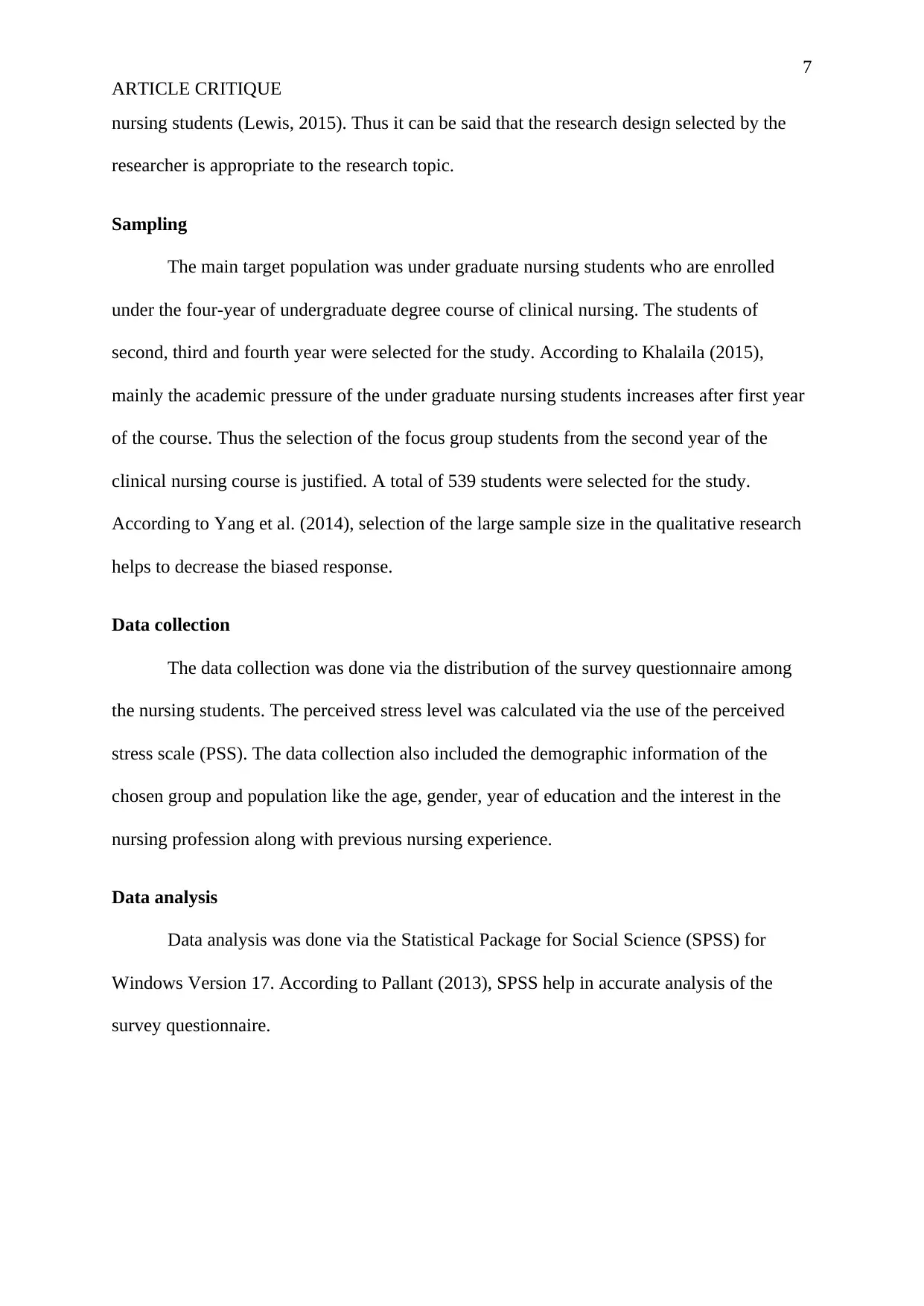
7
ARTICLE CRITIQUE
nursing students (Lewis, 2015). Thus it can be said that the research design selected by the
researcher is appropriate to the research topic.
Sampling
The main target population was under graduate nursing students who are enrolled
under the four-year of undergraduate degree course of clinical nursing. The students of
second, third and fourth year were selected for the study. According to Khalaila (2015),
mainly the academic pressure of the under graduate nursing students increases after first year
of the course. Thus the selection of the focus group students from the second year of the
clinical nursing course is justified. A total of 539 students were selected for the study.
According to Yang et al. (2014), selection of the large sample size in the qualitative research
helps to decrease the biased response.
Data collection
The data collection was done via the distribution of the survey questionnaire among
the nursing students. The perceived stress level was calculated via the use of the perceived
stress scale (PSS). The data collection also included the demographic information of the
chosen group and population like the age, gender, year of education and the interest in the
nursing profession along with previous nursing experience.
Data analysis
Data analysis was done via the Statistical Package for Social Science (SPSS) for
Windows Version 17. According to Pallant (2013), SPSS help in accurate analysis of the
survey questionnaire.
ARTICLE CRITIQUE
nursing students (Lewis, 2015). Thus it can be said that the research design selected by the
researcher is appropriate to the research topic.
Sampling
The main target population was under graduate nursing students who are enrolled
under the four-year of undergraduate degree course of clinical nursing. The students of
second, third and fourth year were selected for the study. According to Khalaila (2015),
mainly the academic pressure of the under graduate nursing students increases after first year
of the course. Thus the selection of the focus group students from the second year of the
clinical nursing course is justified. A total of 539 students were selected for the study.
According to Yang et al. (2014), selection of the large sample size in the qualitative research
helps to decrease the biased response.
Data collection
The data collection was done via the distribution of the survey questionnaire among
the nursing students. The perceived stress level was calculated via the use of the perceived
stress scale (PSS). The data collection also included the demographic information of the
chosen group and population like the age, gender, year of education and the interest in the
nursing profession along with previous nursing experience.
Data analysis
Data analysis was done via the Statistical Package for Social Science (SPSS) for
Windows Version 17. According to Pallant (2013), SPSS help in accurate analysis of the
survey questionnaire.

8
ARTICLE CRITIQUE
Findings
Findings of the research
The research findings highlighted that the perceived level of stress does not varies
with gender differences. The pressure of the completion of the students assignments were
regarded as the main source of stress followed by the stress associated with the patient care
and finally stress coming from the teachers of the other nursing staffs. One of the lowest
source of stress is lack of professional knowledge and skills among the nursing students.
However, the level of stress causes significant damage in the clinical performance by the
female nurse students in comparison to the male nursing students (Akhu-Zaheya et al., 2015).
Over the statistical findings of the research was not represented in a tabular format which
decreased the overall presentation style of the study (Burns, Bush & Sinha, 2014).
Conclusion drawn
The main conclusion of the study is, there is a negative co-relation between the
perceived stress level among the under graduate nursing students and their overall clinical
performance. The effect of stress over the clinical performance is more prominent over the
female nurse students in comparison to the make nurse students.
Recommendation put forth
The main recommendation as proposed by the researchers is a need of framing
strategies in order to increase the confidence of the students while they are taking care of the
patients. This will help to reduce the stress level to certain extent. The researcher also
proposed nurturing of supportive environment by the nursing mentors will further help to
reduce the perceived stress among the nursing students and thereby helping to increase their
clinical performance.
ARTICLE CRITIQUE
Findings
Findings of the research
The research findings highlighted that the perceived level of stress does not varies
with gender differences. The pressure of the completion of the students assignments were
regarded as the main source of stress followed by the stress associated with the patient care
and finally stress coming from the teachers of the other nursing staffs. One of the lowest
source of stress is lack of professional knowledge and skills among the nursing students.
However, the level of stress causes significant damage in the clinical performance by the
female nurse students in comparison to the male nursing students (Akhu-Zaheya et al., 2015).
Over the statistical findings of the research was not represented in a tabular format which
decreased the overall presentation style of the study (Burns, Bush & Sinha, 2014).
Conclusion drawn
The main conclusion of the study is, there is a negative co-relation between the
perceived stress level among the under graduate nursing students and their overall clinical
performance. The effect of stress over the clinical performance is more prominent over the
female nurse students in comparison to the make nurse students.
Recommendation put forth
The main recommendation as proposed by the researchers is a need of framing
strategies in order to increase the confidence of the students while they are taking care of the
patients. This will help to reduce the stress level to certain extent. The researcher also
proposed nurturing of supportive environment by the nursing mentors will further help to
reduce the perceived stress among the nursing students and thereby helping to increase their
clinical performance.
⊘ This is a preview!⊘
Do you want full access?
Subscribe today to unlock all pages.

Trusted by 1+ million students worldwide

9
ARTICLE CRITIQUE
Limitations of the study
According to Akhu-Zaheya, Shaban & Khater (2015), female performance was
greater than male. Though there was no significant difference in stress level but his could be
associated to the course module and the students enrolled under it. However, it was not
possible from author's end to look into this in detail.
Student’s Comment
From the student's perspectives it can be said that study conducted by Akhu-Zaheya,
Shaban and Khater (2015) showed that stress factor during their under graduate course
decrease or hampers their clinical performance. However, if the authors have stated the list of
questions in details then it would have been easier for me to understand the approach taken
by the authors in noting the views and the though process of the students.
Student’s Conclusion
Thus from the critical analysis of the paper, it can be concluded that Akhu-Zaheya,
Shaban and Khater (2015) conducted descriptive, correlation, cross-sectional design in order
to access the relation between stress of nursing students and their clinical performance. The
result showed significant negative co-relation between stress and clinical performance. At the
end, the author's also proposed suitable recommendations in order to overcome such
challenges. The study design and approach taken in order to meet the goals of the research
are clearly justified along with the discussion of limitations.
ARTICLE CRITIQUE
Limitations of the study
According to Akhu-Zaheya, Shaban & Khater (2015), female performance was
greater than male. Though there was no significant difference in stress level but his could be
associated to the course module and the students enrolled under it. However, it was not
possible from author's end to look into this in detail.
Student’s Comment
From the student's perspectives it can be said that study conducted by Akhu-Zaheya,
Shaban and Khater (2015) showed that stress factor during their under graduate course
decrease or hampers their clinical performance. However, if the authors have stated the list of
questions in details then it would have been easier for me to understand the approach taken
by the authors in noting the views and the though process of the students.
Student’s Conclusion
Thus from the critical analysis of the paper, it can be concluded that Akhu-Zaheya,
Shaban and Khater (2015) conducted descriptive, correlation, cross-sectional design in order
to access the relation between stress of nursing students and their clinical performance. The
result showed significant negative co-relation between stress and clinical performance. At the
end, the author's also proposed suitable recommendations in order to overcome such
challenges. The study design and approach taken in order to meet the goals of the research
are clearly justified along with the discussion of limitations.
Paraphrase This Document
Need a fresh take? Get an instant paraphrase of this document with our AI Paraphraser

10
ARTICLE CRITIQUE
References
Akhu-Zaheya, L. M., Shaban, I. A., & Khater, W. A. (2015). Nursing students' perceived
stress and influences in clinical performance. International Journal of Advanced
Nursing Studies, 4(2), 44. https://doi.org/10.14419/ijans.v4i2.4311
Bogossian, F., Cooper, S., Cant, R., Beauchamp, A., Porter, J., Kain, V., ... & FIRST2ACT™
Research Team. (2014). Undergraduate nursing students' performance in recognising
and responding to sudden patient deterioration in high psychological fidelity
simulated environments: an Australian multi-centre study. Nurse Education
Today, 34(5), 691-696. https://doi.org/10.1016/j.nedt.2013.09.015
Burns, A. C., Bush, R. F., & Sinha, N. (2014). Marketing research (Vol. 7). Harlow: Pearson.
Fothergill, A., & Lipp, A. (2014). A guide to critiquing a research paper on clinical
supervision: enhancing skills for practice. Journal of psychiatric and mental health
nursing, 21(9), 834-840. https://doi.org/10.1111/jpm.12161
Khalaila, R. (2015). The relationship between academic self-concept, intrinsic motivation,
test anxiety, and academic achievement among nursing students: Mediating and
moderating effects. Nurse Education Today, 35(3), 432-438.
https://doi.org/10.1016/j.nedt.2014.11.001
Lewis, S. (2015). Qualitative inquiry and research design: Choosing among five
approaches. Health promotion practice, 16(4), 473-475.
https://doi.org/10.1177/1524839915580941
Pallant, J. (2013). SPSS survival manual. McGraw-Hill Education (UK). Retrieved from:
https://books.google.co.in/books?
hl=en&lr=&id=fZZTBgAAQBAJ&oi=fnd&pg=PR7&dq=SPSS+survival+manual&ot
s=KVIwkQWXBR&sig=FWuLRD1mDOGUZMCR4RuEMJ4sUDY#v=onepage&q=
SPSS%20survival%20manual&f=false
Parahoo, K. (2014). Nursing research: principles, process and issues. Macmillan
International Higher Education. Retrieved from: https://books.google.co.in/books?
hl=en&lr=&id=5ti3AwAAQBAJ&oi=fnd&pg=PP1&dq=Nursing+research:
+principles,
+process+and+issues&ots=RBwCUzLoy_&sig=4SNJE3kU4FaZwae4uy2HUqKqOZ
c
Reeve, K. L., Shumaker, C. J., Yearwood, E. L., Crowell, N. A., & Riley, J. B. (2013).
Perceived stress and social support in undergraduate nursing students' educational
experiences. Nurse Education Today, 33(4), 419-424.
https://doi.org/10.1016/j.nedt.2012.11.009
Ritchie, J., Lewis, J., Nicholls, C. M., & Ormston, R. (Eds.). (2013). Qualitative research
practice: A guide for social science students and researchers. Sage. Retrieved from:
https://books.google.co.in/books?
hl=en&lr=&id=EQSIAwAAQBAJ&oi=fnd&pg=PP1&dq=Qualitative+research+prac
tice:
+A+guide+for+social+science+students+and+researchers&ots=l_SPguYy_Q&sig=6
DG4KtucyAdoJwhVFVJuvOrrbcs#v=onepage&q=Qualitative%20research
ARTICLE CRITIQUE
References
Akhu-Zaheya, L. M., Shaban, I. A., & Khater, W. A. (2015). Nursing students' perceived
stress and influences in clinical performance. International Journal of Advanced
Nursing Studies, 4(2), 44. https://doi.org/10.14419/ijans.v4i2.4311
Bogossian, F., Cooper, S., Cant, R., Beauchamp, A., Porter, J., Kain, V., ... & FIRST2ACT™
Research Team. (2014). Undergraduate nursing students' performance in recognising
and responding to sudden patient deterioration in high psychological fidelity
simulated environments: an Australian multi-centre study. Nurse Education
Today, 34(5), 691-696. https://doi.org/10.1016/j.nedt.2013.09.015
Burns, A. C., Bush, R. F., & Sinha, N. (2014). Marketing research (Vol. 7). Harlow: Pearson.
Fothergill, A., & Lipp, A. (2014). A guide to critiquing a research paper on clinical
supervision: enhancing skills for practice. Journal of psychiatric and mental health
nursing, 21(9), 834-840. https://doi.org/10.1111/jpm.12161
Khalaila, R. (2015). The relationship between academic self-concept, intrinsic motivation,
test anxiety, and academic achievement among nursing students: Mediating and
moderating effects. Nurse Education Today, 35(3), 432-438.
https://doi.org/10.1016/j.nedt.2014.11.001
Lewis, S. (2015). Qualitative inquiry and research design: Choosing among five
approaches. Health promotion practice, 16(4), 473-475.
https://doi.org/10.1177/1524839915580941
Pallant, J. (2013). SPSS survival manual. McGraw-Hill Education (UK). Retrieved from:
https://books.google.co.in/books?
hl=en&lr=&id=fZZTBgAAQBAJ&oi=fnd&pg=PR7&dq=SPSS+survival+manual&ot
s=KVIwkQWXBR&sig=FWuLRD1mDOGUZMCR4RuEMJ4sUDY#v=onepage&q=
SPSS%20survival%20manual&f=false
Parahoo, K. (2014). Nursing research: principles, process and issues. Macmillan
International Higher Education. Retrieved from: https://books.google.co.in/books?
hl=en&lr=&id=5ti3AwAAQBAJ&oi=fnd&pg=PP1&dq=Nursing+research:
+principles,
+process+and+issues&ots=RBwCUzLoy_&sig=4SNJE3kU4FaZwae4uy2HUqKqOZ
c
Reeve, K. L., Shumaker, C. J., Yearwood, E. L., Crowell, N. A., & Riley, J. B. (2013).
Perceived stress and social support in undergraduate nursing students' educational
experiences. Nurse Education Today, 33(4), 419-424.
https://doi.org/10.1016/j.nedt.2012.11.009
Ritchie, J., Lewis, J., Nicholls, C. M., & Ormston, R. (Eds.). (2013). Qualitative research
practice: A guide for social science students and researchers. Sage. Retrieved from:
https://books.google.co.in/books?
hl=en&lr=&id=EQSIAwAAQBAJ&oi=fnd&pg=PP1&dq=Qualitative+research+prac
tice:
+A+guide+for+social+science+students+and+researchers&ots=l_SPguYy_Q&sig=6
DG4KtucyAdoJwhVFVJuvOrrbcs#v=onepage&q=Qualitative%20research

11
ARTICLE CRITIQUE
%20practice%3A%20A%20guide%20for%20social%20science%20students%20and
%20researchers&f=false
Yang, J., Zaitlen, N. A., Goddard, M. E., Visscher, P. M., & Price, A. L. (2014). Advantages
and pitfalls in the application of mixed-model association methods. Nature
genetics, 46(2), 100. Retrieved from: https://www.nature.com/articles/ng.2876
ARTICLE CRITIQUE
%20practice%3A%20A%20guide%20for%20social%20science%20students%20and
%20researchers&f=false
Yang, J., Zaitlen, N. A., Goddard, M. E., Visscher, P. M., & Price, A. L. (2014). Advantages
and pitfalls in the application of mixed-model association methods. Nature
genetics, 46(2), 100. Retrieved from: https://www.nature.com/articles/ng.2876
⊘ This is a preview!⊘
Do you want full access?
Subscribe today to unlock all pages.

Trusted by 1+ million students worldwide
1 out of 12
Related Documents
Your All-in-One AI-Powered Toolkit for Academic Success.
+13062052269
info@desklib.com
Available 24*7 on WhatsApp / Email
![[object Object]](/_next/static/media/star-bottom.7253800d.svg)
Unlock your academic potential
Copyright © 2020–2025 A2Z Services. All Rights Reserved. Developed and managed by ZUCOL.





